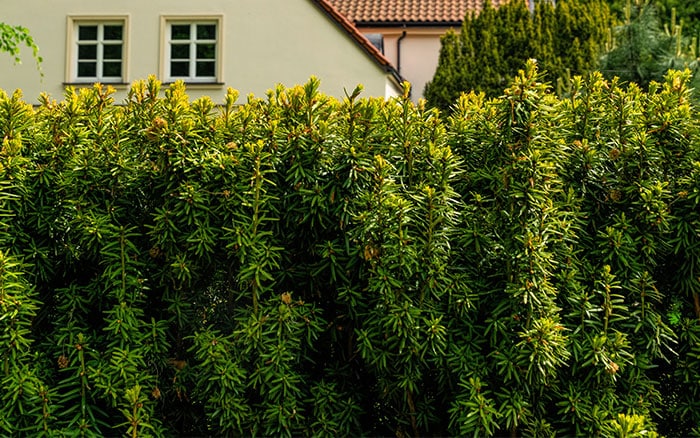Pests and diseases like Box Blight and Box Moth Caterpillar may have caused some damage to your Buxus sempervirens. Therefore, find out some of my favourite alternatives to box hedge.
Common box hedge has been a popular hedging plant for many years. Because they provide ample screening, and cope well with pruning regularly. Also, they are tolerant of most soils, including poor soils and drought.
However, box moth caterpillar and box blight have plagued them in recent years, causing die-back. If you want to avoid this pest and disease, I have found a few alternative options to box hedge that you could try in your garden.
Taxus baccaata (Yew)

Used for centuries as an effective hedge, Yew is valued for its dense foliage throughout the year. I find it provides privacy, shelter from the wind, and a lovely attractive backdrop for your garden.
And copes well with clipping, which is why it is often used as an alternative to box hedge, for shaping into a hedge or topiary.
Did you know?
The ancient Romans believed that Yew plants grew in hell. Which is perhaps why for years it has earned the symbolism of doom.
Euonymus japonicus (Evergreen spindle)

Another great alternative is the evergreen spindle. A native to Japan, Korea, and Kora, they are compact, evergreen, and have dense foliage, which is great for shelter in the garden. Plus, they are slow-growing and compact, and so are a great choice if you would like some low border edging.
Lonicera nitida

This shrubby honeysuckle plant is a great choice, sometimes referred to as ‘box-leaved honeysuckle’. I think that the small, oval leaves are likely responsible for this moniker. Because they are similar in shade and shape to Box hedge.
Additionally, they are highly tolerant of being clipped, so these hedges are great for formal hedging.
Did you know?
Lonicera nitida is a really great plant for supporting wildlife in the garden. The new shoots are attractive to blackfly. Consequently, these attract beneficial insects and creatures such as birds Blue tits, lacewings, and even ladybirds.
Ilex crenata

This robust plant is often chosen as an alternative to box hedges. Unaffected by box blight and box caterpillar, this slow-growing evergreen’s leaves closely resemble those of Box hedge.
Finally, they are also great for clipping into your preferred shape.
Phillyrea angustifolia (Narrow-leaved mock privet)

A plant which copes well with being trimmed, it makes a wonderful medium-sized hedge or topiary.
Also, when left to their own devices, Phillyrea angustifolia will grow into a round bush in a compact shape.
Did you know?
These plants are related to olive trees, and were originally growing in the Mediterranean before being introduced to the UK in the 17th century.
Pittosporum tenuifolium ‘Golf Ball’

I find these naturally mound-shaped shrubs are particularly suited to be a box hedge alternative. This is thanks to their dense, compact and rounded shape.
‘Golf Ball’ especially grows well for these purposes. The glossy and wavy-edged leaves grow on black stems, making the plant all the more striking.
Did you know?
The name ‘Pittosporum’ translates quite literally to ‘sticky seeds’. This is because the seeds produced by this plant have a sticky texture to their surface.
Osmanthus burkwoodii

Great for growing into a medium-hedge or for edging a low border. And, Osmanthus burkwoodii is well suited to being a box hedge option.
Plus, they have grown in popularity as a hedge in recent years thanks to the intense shade of their dark green leaves.

Leave A Comment